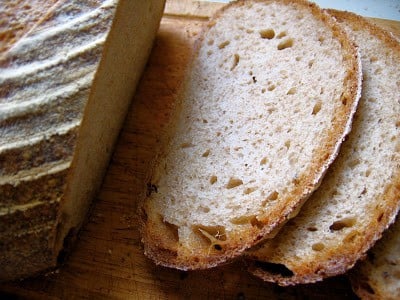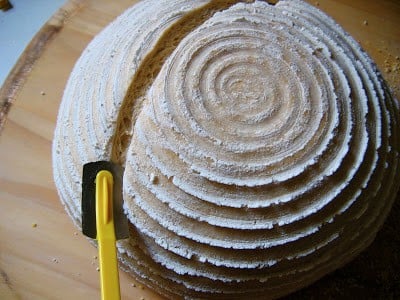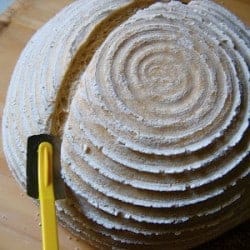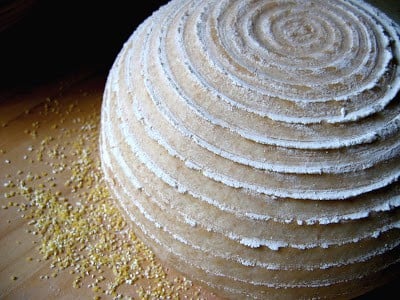This homemade sourdough bread recipe produces a full-flavored boule with an open crumb and a nicely caramelized crust. Adapted from Nancy Silverton.

San Francisco Sourdough Bread
The first homemade sourdough bread I ever baked, four years ago, turned out as hard and dense as a brick. Living in the sourdough capital of the world, San Francisco, I felt like a real loser. I had followed a lengthy recipe, raising my own sourdough starter from flour and water, nurturing it for three whole days until it began to bubble and smell tangy. My failure probably had more to do with a weak, newborn starter than anything else, but that was cold comfort. As my starter matured, though, the bread I baked with it came out better and better.
Everything Starts with Sourdough Starter
Since then, I've raised a few different starters, but I'd always end up killing them out of neglect when the summer months came and it was too hot to fathom cranking the oven up to 500º. Then, last spring, I inherited the most active, robust starter I've ever had the pleasure of baking with. I don't know the origins of this starter, and have suspicions that it may have been started with commercial yeast. But that doesn't matter to me now. I can ignore my starter in the fridge for weeks, then take it out and feed it with nary a pout or obstinate refusal to rise. Instead, it bubbles up beautifully, like a wagging dog greeting you at the door after you've been gone all day, leash in snout, eager for a walk. "No need to make pancakes," it tells me, "I'm ready for the big guns." This one's a keeper.
Tools of the Sourdough Trade
Over the years I've equipped myself with the proper sourdough bread baking materials: a baking stone, a coiled willow rising basket, and a lame for slashing the unbaked loaves, as well as the sourdough bible, Nancy Silverton's Breads From the La Brea Bakery, which includes, aside from dozens and dozens of sourdough loaves, boules and flatbreads, recipes for sourdough pancakes, doughnuts, onion rings, and even a souffle-like sourdough chocolate cake. I cannot recommend this book highly enough for anyone interested in baking sourdough bread, novice and pro alike.
Though Nancy has been with me through many a glorious loaf, she also encourages one to strike out on ones own. So I decided to write my own sourdough bread recipe.
My Best Artisan Sourdough Bread Recipe
Most rustic sourdough bread recipes call for a very little bit of starter, half a cup or so per large loaf. This really bugs me, since I always have such a surplus of starter. I decided to try tripling the amount called for in Nancy Silverton's artisan sourdough bread recipe, adjusting the quantities of the other ingredients accordingly. It was the best sourdough bread I've baked yet; a bit denser than Acme's Levain, my naturally leavened holy grail, but every bit as chewy and full flavored, with an open crumb and a nicely caramelized crust.
Whole Wheat Sourdough Bread
This recipe gets some whole-grain flavor from whole wheat flour and wheat germ, but it still bakes up light and chewy from plenty of white bread flour.
What to do with Leftover Sourdough Bread
Any leftover sourdough bread can be made into killer sourdough croutons. Around these parts, we cube extra bread and store it in the freezer, then fry it in olive oil in a cast-iron skillet, add a sprinkling of salt, and munch them on salads and soups.
Is Sourdough Bread Vegan?
Yes! This vegan sourdough bread recipe doesn't contain any animal products and is friendly for all your vegan and dairy-free bread-eaters.
Is Sourdough Bread Gluten-Free?
This one is NOT gluten-free (though these days most of my newer recipes are!) If you're looking for a gluten-free sourdough bread recipe, try this multi-grain sourdough bread recipe from Vanilla & Bean or this sourdough boule recipe from Bob's Red Mill.
Looking for more sourdough recipes? Try these:
- Sourdough Rye Bread
- Sourdough Olive Bread
- Sourdough Pie Crust & Apple Pie
- Sourdough Pizza Crust & Mushroom Pizza
- Sourdough Waffle Recipe
- Sourdough Deep Dish Pizza Recipe
- Sourdough Pancakes with Apple & Cheddar
- Easy Sourdough Focaccia
More Bread Recipes:


Homemade Sourdough Bread
Print Recipe Pin RecipeIngredients
- 12 oz. liquid sourdough starter, active, bubbly and ready to go (about 1 1/2 cups stirred down, or 3+ cups at full froth)
- 8 oz. room temperature or lukewarm water (1 cup)
- 1 oz. wheat germ (1/4 cup)
- 5 oz. whole wheat bread flour (1 cup)
- 8 - 10 oz. white bread flour (1 2/3 - 2 cups)
- 1/4 oz. sea salt (2 1/4 teaspoons)
Instructions
- Stir together the ingredients in a large bowl in this order until a rough dough forms. Add more bread flour if your dough is very wet. Scrape the dough out onto a lightly floured surface (a stiff, plastic scraper is perfect for this), invert the empty bowl over the dough, and let it rest for 20 minutes. (This is called autolyse and allows the flour to absorb some of the water and the gluten strands to begin straightening out; it makes for less kneading in the end, and will prevent you from adding too much flour right off the bat.)
- After 20 minutes, remove the bowl and knead the dough vigorously for about 10 minutes, adding as little flour as possible to prevent the dough from sticking to your hands and the surface, until it feels smooth, springy and elastic.
- Place the dough in a large, lightly oiled ceramic bowl or a large plastic container at least twice the size of the dough. You can mark the outside of the vessel with a piece of masking tape where the dough will be when it doubles, if you like. Cover the vessel tightly with plastic wrap or the lid, and allow it to rise until doubled, three to four hours. The warmer the spot you choose, the faster it will rise, the ideal temperature being 75-85º. You can also let the dough rise in the fridge or a cool place overnight. Let the dough come to room temperature before shaping it, and be sure that it has doubled in bulk to properly develop the glutens.
- Gently turn the dough out onto a lightly floured surface, pressing out the air bubbles. Shape into a boule by tucking the edges under itself, then gently rotating the dough on the surface to form a taught outer layer of dough. Here's a quick video of how to shape a boule.
- If you have a rising basket, sift a light layer of flour onto the inside, and place the boule in it upside-down, pinching the seam shut. (If you don't have a rising basket, place the boule directly on a peel or board dusted with cornmeal or flour.) Place the whole deal in a large plastic bag, such as a trash can liner. Inflate the bag and close it with a twist tie or clip. Let the bread rise a second time until doubled, about 1 1/2 - 2 hours.
- When the bread is ready to bake, it will hold an indentation of your finger when you press it lightly, rather than springing back. While the bread is rising, about an hour before you're ready to bake, remove all but the bottom rack of your oven. Place a baking stone on the rack (or a heavy duty baking sheet), and place a metal pan that you don't care about sacrificing (it will get rusty) on the floor of the oven. Crank the oven up to 500º.
- When the bread has doubled, gently turn it out onto a wooden peel dusted with flour or cornmeal. Holding a lame or sharp knife at a 45º angle to the loaf, draw the blade, about 1" deep, across the top of the loaf, beginning and ending 2" from the bottoms of the boule. (Just look at the darn picture, ok?) Fill a 1 cup measure with ice cubes. Quickly slip the boule off the peel and onto the stone, and toss the cubes into the hot pan on the floor of the oven. This will steam the outside of the loaf, allowing it to expand as it bakes.
- Bake 20 minutes, then turn the oven down to 450º and bake another 20 minutes or so, until the bread is a deep, burnished golden-brown. An instant read thermometer inserted into the middle should read 210º, the temperature at which the dough is set.
- Let cool completely on a wire rack, one to two hours, before enjoying. At this point, the bread is still "baking" from the residual heat and steam inside the loaf. The best way to store this type of bread is in a paper bag at room temperature for a couple days. After that, I put the whole thing, paper bag and all, into a plastic bag and continue to store at room temp. After a couple of days like that, it there's any left over, we make croutons.





racheljherr says
As I type my sourdough is in the middle of its first rise, per Nancy Silverton's direction. I've had two so-so results and this is my third try at the basic country white loaf. Your entry has been helpful; thanks!
alanna says
Awesome - I hope it came out well! So much of sourdough baking is just getting your starter strong enough in the first place. Give the sourdough focaccia on this site a try sometime - really good, and really easy (if I do say so).
Paula says
Thank you for this simple recipe. After spending 2 weeks developing Nancy Silverton's starter, this recipe does it justice! My first attempt at this sourdough boule was a success! I appreciate the easy to follow directions, and plan on making this my go to sourdough recipe!
alanna says
I am so glad to hear that - happy baking! : )
Xeratdark.Hostinggratis.it says
Bookmarked this web page, will come back for more articles.
You, my friend, ROCK! I found just the information I already searched all over the place and just could not come across.
What a great site.
Alex Lamm says
I'm obsessed with this bread! I've made it so many times and I just wanted to let you know how much I love it. I do have a question about the salt. In your two olive sourdough loaf you have the salt go in after the autolyse process and in this one it goes in from the jump. Is there a reason why? Just curious! p.s. today I'm adding seeds into the dough. I hope it isn't lame. LOL.
Alanna says
Hi Alex! I'm so glad you're loving this recipe! That's a great question about the salt.There are theories about the best point at which to add salt in a bread recipe since it has an effect on the glutens and yeast. But I'm not sure why I did it differently in two recipes that I published a week apart! But given that I add the yeast at the beginning of my most recent sourdough recipe, I'm going to go ahead and say that you can add it at either stage and the recipes will work. If you experiment, please let me know!
Let me know how the seedy version turns out - obviously I'm a big fan of seeds too!
Holly Hon says
Hi, in your GF sourdough recipe, it calls for liquid starter. Which GF starter you used? The one on the Vanilla bean blog is different from Bob’s Mills. Or do you used a different one completely? I am finding a sourdough starter recipe on your blog. Thanks for your response and guidance in advance.
Alanna Taylor-Tobin says
I'm so sorry for the confusion - the sourdough recipes on my site are all wheat-based, from before I went GF. I would go with Vanilla and Bean, or check out Aran at Canelle e Vanille!
Leatha says
Can you leave out the wheat germ?
Alanna Taylor-Tobin says
I think that should work fine. Please let me know how it turns out!